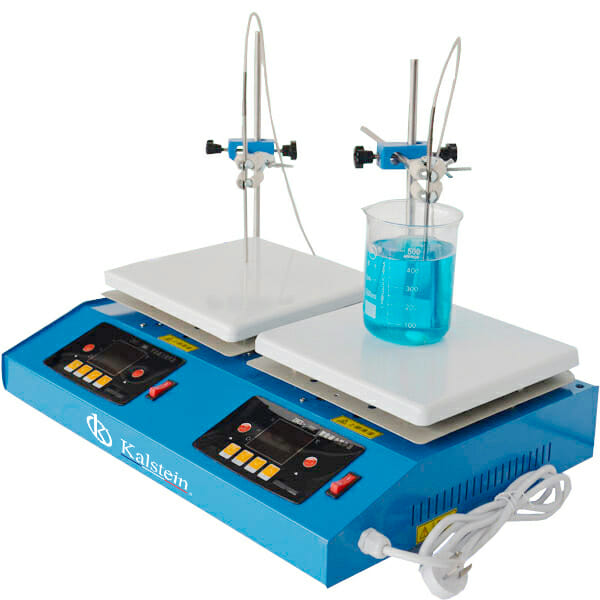Heating plates are often used in laboratories to supply the heat required by chemical reactions, heat samples and other activities that are of interest to the analyst. An electric heating plate is conceptually simple: a flat surface with a device that generates heat when provided with electrical current. So, to heat a substance just put it in a proper container and then on the plate, and light it.
One of the advantages of heating substances in this way, is that they do not create open flames. However, there are important considerations when it comes to choosing the right boards and important security factors that users should pay attention to. The plates are suitable for oil or sand baths, and the use of such baths extends the use of the plates and can heat substances within spherical bottom containers such as:
- Distillation flasks.
- Spherical reactors.
- Test tubes.
What are the particular characteristics of heating plates?
From a design perspective, heating plates can be significantly differentiated, taking into account the materials and the electronics with which they are made. Currently, most have built-in magnetic stirrers, which is desirable if liquid substances are heated, as it facilitates the uniform distribution of heat and eliminates the need for an external stirrer.
The surfaces of hot plates differ, but in general, they are made of ceramic, stainless steel or aluminum, both coated with ceramics. This variety of materials on the heating plate is related to the compatibility of the materials that will be heated in the laboratory. Another important element is the heat transfer properties of the surface and the temperature that needs to be reached. In general, it is suggested to choose a different heating plate if the higher setting is used frequently.
Some heating plates allow the reading of the working parameters in digital form, and have inputs for thermocouples so that you can control directly and accurately the heat bath. Currently, some heating plates incorporate built-in safety features, which automatically turn off the plate if the temperature falls outside the default working range. These features provide additional benefits by improving the process and safety of routine laboratory work.
What are the precautions to take when using a heating plate?
Current hot plates have heat-generating devices sealed and generate almost no electrical sparks (they may be absent). Despite this, it is still possible that explosions occur when organic substances such as solvents are heated, being necessary to carry out this process in a gas extraction campaign that extracts the vapors generated to the outside atmosphere of the laboratory. The air flow in the fume hood will keep the solvent vapor levels below the flammable range.
If older heating plates are present in the laboratory, spark risks are likely due to its on/off switch and thermostat designs. In this sense, the bimetallic thermostats of the older models can be closed by fuse and supply full direct current to a heating plate. Here are some safety tips to consider when using a heating plate:
- Check not to confuse the heating knob of the stirring knob, as in some equipment models, they are very similar.
- Check the ignition, as in case of failures, the board continues to warm up when it is off causing fires. It is therefore recommended to disconnect them from the power supply when they are not in use.
- Use glass containers made of heat-resistant material such as borosilicate. On the other hand, the use of thick-walled glassware directly on hot plates is not recommended, as they can be unevenly heated and may break or crack.
- Avoid handling flammable chemicals or fuels near heating plates; you risk reaching flash point temperature.
- Direct heating of solvents, especially low-boiling solvents such as ether and carbon disulfide (30-60° boiling point), represents a fire risk and should be avoided. Using a water bath provides more uniform heat distribution and more control over temperature. If it is necessary to boil such solvents, it is not recommended to use an open beaker or flask; instead, a condenser is appropriate.
The benefits of Kalstein heating plates
Kalstein heating plates provide many benefits that come from all the potential uses they have, their design and technology, and to follow the necessary care of their use; in addition, the prices of these devices compete with those of the market. These instruments allow measuring the working temperature, precise control of the working parameters, in addition to being built in resistant materials. For more technical specifications, please visit HERE and HERE

